
10 minute read
Performance Evaluation of Antimony/Zinc Diamyl Dithiocarbamate as Grease Additive
Aili Ma, Minli Gu, and Junbing Yao VANDERBILT (BEIJING) TRADING, LTD Mihir K. Patel, Ruiming “Ray” Zhang VANDERBILT CHEMICALS, LLC
ABSTRACT
The Extreme-Pressure (EP), antiwear (AW), frictionreducing (FR) and antioxidation (AO) performances of antimony/zinc mixed metal diamyl dithiocarbamate (Sb/ ZnDTC) as a grease additive are evaluated. The four-ball tests show that, the Sb/ZnDTC a mixed metal organic salt, exhibits excellent EP, good AW, but no FR performances in lubricating base oil. Whereas it exhibits good EP, but no obvious AW and FR capacities in lithium complex, polyurea and calcium sulfonate complex greases. The combination of Sb/ZnDTC and molybdenum dialkyl dithiocarbamate (MoDTC), a known AW and FR additive, could give a balanced overall performance in grease with high EP and excellent FR/AW characteristics. The MTM (Mini Traction Machine) Stribeck curves indicate, Sb/ZnDTC could effectively reduce the friction coefficients under boundary and mixed lubrication regimes in calcium sulfonate complex grease, especially at high temperature. In addition, the PDSC (Pressure Differential Scanning Calorimetry) oxidation test proves that Sb/ZnDTC is an excellent antioxidant in greases as a hydroperoxide decomposer.
KEYWORDS
Grease, Dithiocarbamate, Antimony, Zinc, ExtremePressure, Antioxidant
1. INTRODUCTION
Antimony, same as phosphorus, belongs to the Group VA in the periodic table of the elements, possesses some extremepressure (EP) and antiwear properties too. Extreme Pressure (EP) performances, especially the Timken OK loading capacity, of greases and oils have long been enhanced by the use of antimony dithiocarbamate (SbDTC)[1-6]. However, it is very important to try to limit the amount of antimony into the environment, due to the environmental and health concerns over its toxicity as a heavy metal element. It is a challenge to utilize low amount of antimony dithiocarbamate in lubricating oils and greases to achieve high EP performances. Very meaningfully, the in situ (in one kettle) preparation of zinc dialkyl dithiocarbamate (ZnDTC) in the preparation of antimony dithiocarbamate (SbDTC) has allowed for the significant reduction of the SbDTC needed while maintaining the necessary EP properties of the grease composition as determined by the Timken OK load test[7][8]. The in situ synthesis of this di-metal salt of dithiocarbamate (Sb/ZnDTC) from a secondary amine, carbon disulfide and antimony (III) oxide, Sb2O3, and zinc (II) oxide, ZnO can be describe as follows:
The EU Classification of Xn (harmful) N (dangerous for the environment) for concentration of Antimony (Sb) is: Sb ≥ 25 %, Xn, N, R20/22-51/53; 2.5 % ≤ Sb < 25 %, Xn, R20/22-52/53; and 0.25 % ≤ Sb < 2.5 %, Xn, R20/22. Therefore it is very important for the concentration level of antimony in grease to be less than 0.25%. Reduced antimony content in greases without the loss of EP capability or the need for sulfurized olefin or ester with strong odor could be achieved by this synthesis method. The Sb/ZnDTC by this in situ (in one kettle) synthesis can guarantee an excellent EP performance, when Sb is less than 0.25% in greases. The comparison between the bi-metal salt of dithiocarbamate by in situ synthesis and its simple blending (SbDTC + ZnDTC) was given as in the Table 1[8] .
The Sb/ZnDTC by in situ synthesis outperforms the physical mixture of SbDTC and ZnDTC, moreover, it does not have the sulfurized olefin’s drawbacks of pungent odor and lowering dropping point of lithium complex grease.


2. EXPERIMENTAL / MATERIALS AND METHODS
2.1 Base Oil, Greases and Additives
Base oil used in this study is 650SN Group I base oil. Base greases used include a lithium complex grease, a polyurea grease and a calcium sulfonate complex grease. All three base greases were obtained from real production batches by courtesy of two grease manufacturers.
The in situ liquid Sb/ZnDTC additive has antimony, zinc and sulfur content of 5.8%, 4.5%, and 18.5% respectively, and contains 20% petroleum base oil. In this paper, the additive is designated as Sb/ZnDTC. The interaction between Sb/ZnDTC and an organo-molybdenum additive is also investigated in this paper for an overall balance EP, AW and FR performances in greases. The Molybdenum additive evaluated is a solid molybdenum dibutyl dithiocarbamate, which contains the molybdenum of 28.0% and the sulfur of 24.5%. This Mo additive is designated as MoDTC. These two additives are commercially available.
2.2 Four-Ball Friction and Wear Test
The four-ball friction and wear test method of standard ASTM D2266 for grease and D4172 for oil were used to evaluate additive performances in lubricating oil and greases. Experimental conditions were: 40 kgf load, 1200 rpm speed, 60 minutes, and 75oC. Real-time recording of coefficient of friction during the test is also available with the specific four-ball test machine used, in addition to measurement of wear scar diameters.
2.3 Four-Ball EP test
Standard ASTM D2596 four-ball EP test method was used to evaluate additive EP performance in greases. Experimental conditions were: 1770 rpm speed, time duration 10 seconds. Both last nonseizure load (LNSL) and weld point were measured.
2.4 MTM Stribeck Curve
Mini Traction Machine (MTM) was used to evaluate frictional characteristics in boundary and mixed lubrication regime (Stribeck Curve) with “Ball on Disc” configuration. MTM consists of a rotating a 52100 steel ball pressed against an independently rotating 52100 steel disc immersed in the grease. The operating conditions are set by independently controlling the rotational velocities of the shafts that drives the ball and the disc, in order to obtain a particular combination of rolling speed and slide to roll ratio, as well as by controlling the contact force and the oil bath temperature. The test conditions: 35N load (Equivalent to 1GPa hertzian point contact load), 50% Slide to Roll Ratio, each Stribeck curves at 40⁰C, 60⁰C, 80⁰C, 100⁰C, 120⁰C and 140⁰C, Mean speed were started at 1000 mm/s and decreasing in steps of 100 mm/s to 100 mm/s and finally decreased from 100 mm/s in steps of 10 mm/s to 10 mm/s. The operation scheme of MTM is illustrated as in Figure 1.
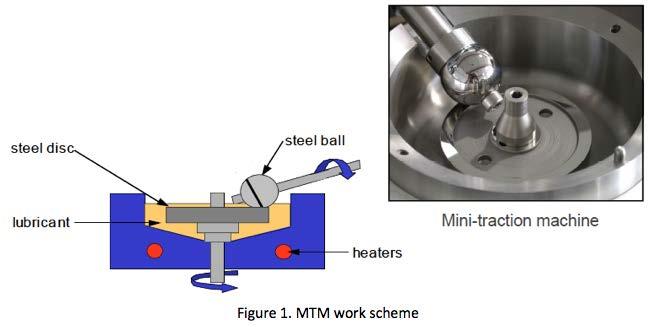
2.5 PDSC oxidation test
PDSC (Pressure Differential Scanning Calorimetry, ASTM D6186) was used to measure the oxidation in greases. A small quantity of oil is weighed into a sample pan and placed in a test cell. The cell is heated to a specified temperature and then pressurized with oxygen. The cell is held at a regulated temperature and pressure until an exothermic oxidation reaction occurs. The extrapolated onset time is measured and reported as the oxidation induction time (OIT) for the lubricating oil or grease at the specified test temperature. The test conditions: 3.5MPa pressure, 180, 200 and 210oC temperatures, 3.0 mg grease sample, and 100ml/min oxygen flow.
3. RESULTS AND DISCUSSION
3.1 Tribological performances in base oil
Sb/ZnDTC was added into Group I base oil, and the tribological performances were evaluated by four-ball friction and wear tests. The experimental results are given in Table 2.
It can be seen from Table 2 that, Sb/ZnDTC possesses excellent EP, good AW performances, but no obvious FR capacity in the base oil.
3.2 Tribological performances in greases
Sb/ZnDTC was added into lithium complex, polyurea and calcium sulfonate complex base greases, and the tribological performances were evaluated by four-ball friction and wear tests. The experimental results are given in Table 3.
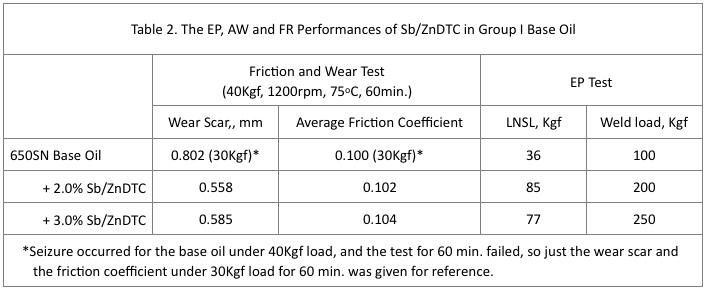
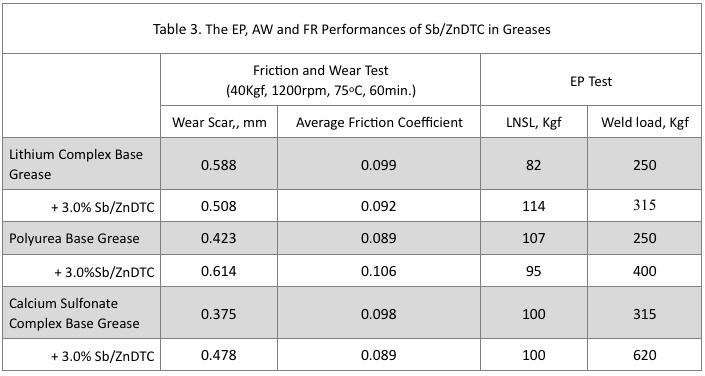
It shows in Table 3 that, Sb/ZnDTC exhibits good four-ball EP performance, but no obvious FR capacity in the greases, and the AW properties can only be found in the lithium complex base grease. Thus, Sb/ZnDTC can only be treated as an EP additive in greases, and another kind of additive is needed in combination with it to achieve an overall balanced EP, AW and FR performances.
3.3 Tribological performances with organo-molybdenum additive in greases
As showed in Table 3, Sb/ZnDTC is not a good AW and FR additive for greases, so AW and FR additive is needed with it for the comprehensive performances. Molybdenum dibutyl dithiocarbamate (MoDTC) is well-known for its excellent FR and AW performances in greases [9]. Actually, the successful combination of SbDTC and MoDTC in lithium, lithium aluminum mixed greases for high Timken OK load, high four-ball wear load, low wear scar and low friction has already been reported [3].
Sb/ZnDTC and MoDTC were added into the calcium sulfonate complex base grease, and the tribological performances were evaluated by four-ball friction and wear tests. The experimental results are given in Table 4.
It is evident from Table 4 that, in the calcium sulfonate complex grease, the combination of Sn/ZnDTC with MoDTC can achieve excellent EP, AW and FR performances simultaneously. The wear scars and the friction coefficients of the greases with and without Sb/ ZnDTC and/or MoDTC are shown in Figures 2 and 3.



It can be seen that, in the calcium sulfonate complex grease, the combination of Sb/ZnDTC and MoDTC could achieve excellent FR and AW performances, while keeping the high EP properties (weld load, from 250Kgf to 620Kgf).
3.4 MTM Stribeck curve
3.0% Sb/ZnDTC was added into the calcium sulfonate complex base greases, and the frictional properties under slide/roll conditions were evaluated using Mini Traction Machine (MTM). The Stribeck curves at different temperature are shown in Figure 4.
From Figure 4, it could be found that, with the increase of the temperature, the friction-reducing efficiency by Sb/ ZnDTC becomes higher and higher under boundary (10100mm/s) and mixed (100-1000mm/s) lubrication regimes. Especially at middle and high temperatures (≥100oC), Sb/ ZnDTC can reduce the grease’s friction coefficient under almost whole boundary and mixed lubrication regime (101000mm/s).
3.5 Anti-oxidation performance
PDSC was employed to evaluate the antioxidation performance of Sb/ZnDTC in lithium complex, polyurea and calcium sulfonate complex base greases. The oxidation induction times at different temperature are given in Table 5.
The three base grease samples were provided by different grease maker. It seems that the simply polyurea base grease is not always better than simply lithium complex base grease under high temperature, but definitely the polyurea grease has a better response to the antioxidant.
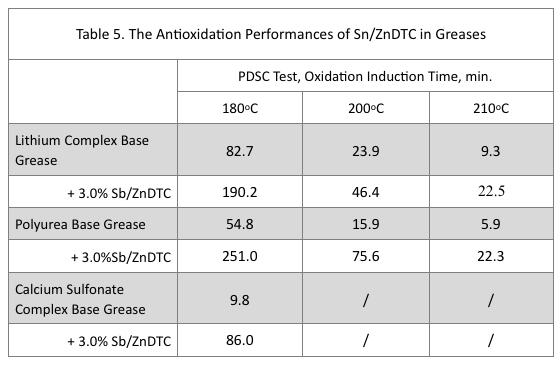

It is evident from Table 5 that, Sb/ZnDTC possesses excellent antioxidation performance in all these three greases, which increases the oxidation induction times significantly. Due to the chemical characteristics as dithiocarbamate derivative, Sb/ZnDTC serves as a hydroperoxide decomposer. The PDSC oxidation diagrams of the polyurea greases with and without Sb/ZnDTC are illustrated in Figure 5. It shows in Figure 5 that, Sb/ZnDTC could increase the OIT of the base polyurea grease more than 3.5 times, which demonstrates Sb/ZnDTC’s outstanding antioxidation capacity in grease.
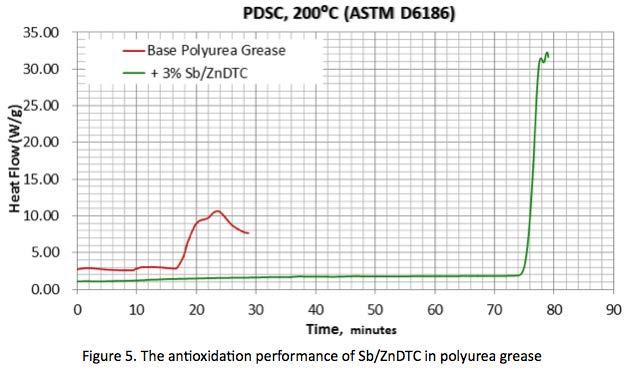
4. CONCLUSIONS
(1) The di-metal salt of dithiocarbamate (Sb/ZnDTC) by in situ synthesis possesses excellent EP, good AW, but no FR performances in base oil; (2) Sb/ZnDTC exhibits good EP performances in lithium complex, polyurea and calcium sulfonate complex greases. (3) The combination of Sb/ZnDTC and molybdenum dialkyl dithiocarbamate (MoDTC) as AW and FR additive, could give a balanced overall performances in grease with high EP and excellent FR/AW characteristics. (4) The MTM (Mini Traction Machine) Stribeck curves indicates, Sb/ZnDTC could effectively reduce the friction coefficients under boundary and mixed lubrications in calcium sulfonate complex grease, especially at high temperature. (5) The PDSC (Pressure Differential Scanning Calorimetry) oxidation test proves that Sb/ZnDTC is an excellent antioxidant in greases as hydroperoxide decomposer.
Reference
[1] H H Farmer, H F Tompkins. Extreme Pressure Lubricants.
US Patent 3,139,405 (1964). [2] Vartanian Paul. Grease Composition with Improved
Extreme Pressure and Antiwear Properties, US Patent 5,246,604 (1993). [3] Bae Dae, Son Sung. Grease for Constant Velocity Joints.
US Patent 5,612,298 (1997). [4] Hall Robert, Blouin Gilles. Color Temperature Indicator for Lubricating Grease. US Patent 5,360,561 (1994). [5] Komiya Hiroshi, Kouno Toshikazu, Kitamura; Masayuki,
Kawaguchi Toshihiro, Okamura Seiji, Iwamatsu Hiroki.
Grease for Rolling Bearing and Grease-Sealed Rolling
Bearing, US Patent 6,432,888 (2002). [6] Junbing Yao, Antimony Compound – Excellent Extreme-
Pressure Additive for Lubricant, Lubricating Oil, 21(4):29-34 (2006) (in Chinese). [7] Ronald Hiza, Gaston Aguilar, Steven Donnelly, Francis
Cheng, Ronald Tepper. Lubricating Greases Containing
Antimony Dithiocarbamates. US Patent 7,772,170 (2010). [8] Kevin Chase, Gaston Aguilar. Metal Dithiocarbamates:
A “New” Approach to “Old” Technology. NLGI 73rd
Annual Meeting, Lake Buena Vista, Florida, 2006. [9] Kawamura Yasushi, Nakazawa Kouichi, Shinoda Noriaki,
Tanaka Keiji, Nimura Tetsuo, Saitou Kouji, Wada
Tomoyasu. Grease composition for constant velocity joints, US Patent 6,894,009 (2005).








